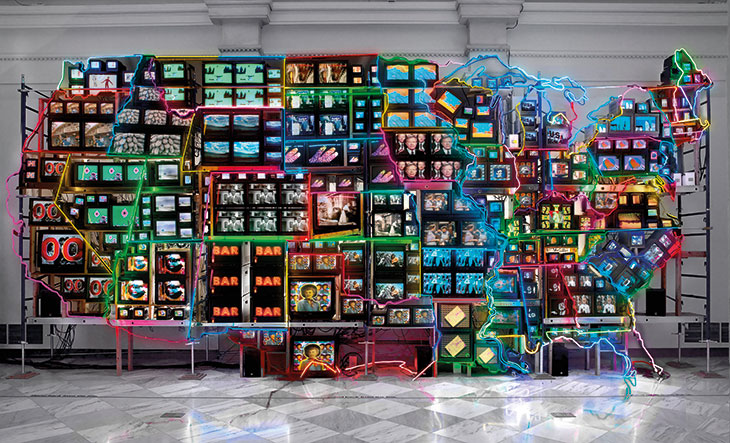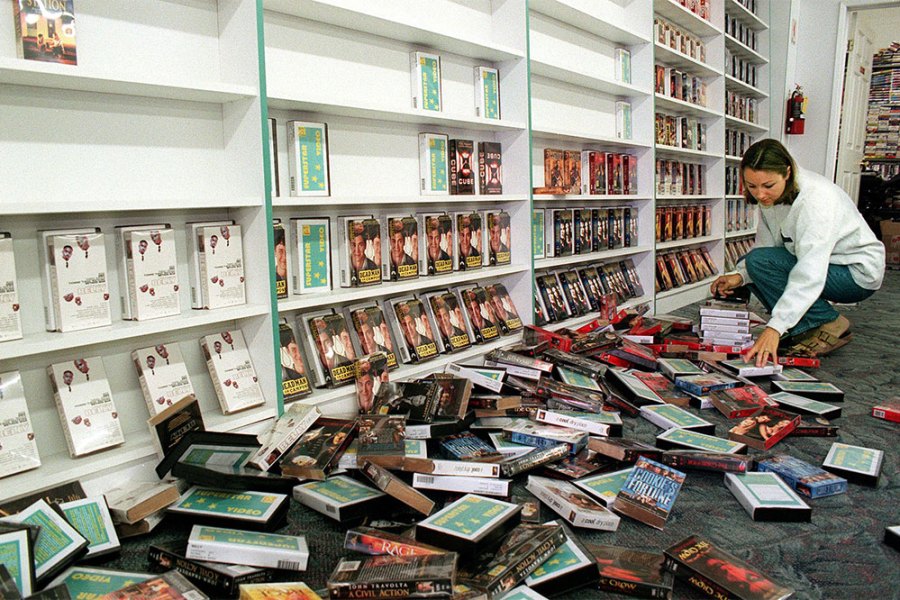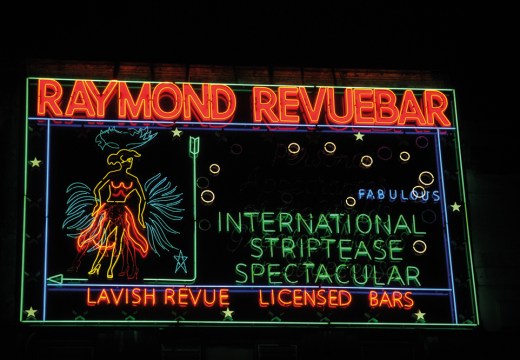From the February 2021 issue of Apollo. Preview and subscribe here.
There’s a mechanical clunk and the screen comes to life with a shiver of interference. Some blocky text might appear at the margins – a date, or the word PLAY. And, after a curtain of white static falls, a picture appears, twitching and settling into motion. For anyone over the age of 20 this sequence is familiar enough to be evocative: the framing device of all sorts of home entertainment, from the slick and professional to the embarrassingly amateur. A video is playing.
For anyone younger, though, there may be less of a frisson of recognition. The age of VHS came to a decisive end more than a decade ago. The first time I saw a video cassette in a charity shop, in a previous century, I was surprised that anyone would donate such a valuable object. By the early 2000s, my local hospice shop in Pimlico, central London, had actual heaps of cassettes, jettisoned by people making the switch to DVD. You could buy entire seasons of Star Trek: The Next Generation for a quid – not a quid per tape, a quid per season. Then the tapes disappeared and a handwritten sign appeared: ‘We no longer accept videos.’ You literally couldn’t give them away.
Bulky and relatively impractical, video never stood a chance against DVD – the digital disc’s triumph was assured the moment it appeared on the market. The battle was brief, too, far quicker than the compact disc’s replacement of audio cassette and vinyl. In recent years, some ‘dead’ formats have returned: vinyl is available again and new LPs are printed, Polaroids were resurrected with considerable technical effort; even the audio cassette has its revivalists. Few, however, mourn VHS.
Nevertheless, the fact that the VHS era is not only closed but also increasingly distant in time does let us view it with newly appreciative eyes. Although the technology is not worth recovering, the format does have a distinct aesthetic that has its aficionados. On the image-sharing sites Tumblr and Instagram there are blogs devoted to fragments of this look – not just retro 1980s telly graphics and shoulder-padded adverts, although there are those in abundance, but also GIFs of mundane flickers, tracking errors and dead screens from the lost world. In art, video today mostly presents a preservation and display problem, but it is also ripe for rediscovery and re-use as a distinct and evocative visual language.
Any discussion of the aesthetic qualities of VHS video is inseparably tangled with the aesthetics of television – specifically, cathode-ray tube (CRT) television, the analogue technology that preceded today’s digital system. Television existed before home video, but video’s rise coincided with colour television’s eclipse of black-and-white; the video and the CRT television fell at much the same time, for much the same reason: the switch to digital technologies. It was CRT that home video captured, and CRT was the means by which it was played back to us, so to describe one technology necessarily involves describing the other. CRT televisions generated an image by firing streams of electrons in three colours – red, green and blue – at a screen in a scanning line. Viewed with the accommodating slowness of the human eye, these rapidly scanning lines produces a moving colour image of tolerable quality. The technology also generates the secondary effects and imperfections we associate with 20th-century television: the perceptible horizontal lines, the up-down flicker, the lack of anything approaching true black, the tilt in the colour palette towards magenta and cyan, the distinctive fuzziness within the picture.
Broadcast television was, initially, a modernist structure, the product of what Marshall McLuhan called ‘Gutenberg Man’. It was hierarchical, centralised, homogenised and homogenising. But the analogue smudginess of the picture promised more. ‘TV offers incredible amounts of psychic data,’ says Murray Jay Siskind, one of the characters in White Noise (1985), Don DeLillo’s great novel about the eroding certainties of American modernity. ‘It opens ancient memories of world birth, it welcomes us into the grid, the network of little buzzing dots that make up the picture pattern. There is light, there is sound. […] The medium practically overflows with sacred formulas if we can remember how to respond innocently and get past our irritation, wariness and disgust.’
What the buzzing dots promised, video was delivering. Sony introduced Betamax, the first consumer video system, in the United States in late 1975. JVC’s VHS standard followed soon after, and by the end of 1978 had the largest share of the market. As Joshua M. Greenberg explores in From Betamax to Blockbuster (2008), a history of video stores, many of the best-known stories about the early days of home video are exaggerated to the point of myth. Betamax’s superiority to VHS was overrated – the former did have better image quality but was hobbled by its one-hour recording time. Also overrated was the contribution pornography made to the early adoption of home video, although it played its part. What really came to shape the cultural impact of video was a crucial lag in its development.
When video first appeared, pre-recorded video cassettes were not yet available. As Greenberg relates, that took a little bit of time and effort. First movie studios and other content makers had to overcome their suspicion of the new technology – Universal Studios sued Sony to stop the distribution of Betamax on piracy grounds, but lost – and then they had to develop an infrastructure for distributing their product that they were comfortable with, the video rental store. (Sale of pre-recorded videos was initially discouraged by artificially high prices.) Video was first marketed as a way of ‘time-shifting’ television: taping it on to blank cassettes, and playing it back later.
This function liberated the viewer from the tyranny of the TV schedule, and in doing so it cracked television’s modernist edifice. The early days of video were in the hands of amateurs and enthusiasts. This drove the spread of the new technology, as users discovered and popularised new uses, but also gave it a subversive edge. The author J.G. Ballard, always better able to see around the corner than his peers, was early to notice the liberating, unsettling potential of video. ‘No longer will [the average individual] have to accept the relatively small number of permutations of fantasy that the movie and TV companies serve up to him,’ Ballard said in 1979, ‘but he will be able to generate whatever he pleases to suit his whim.’ This gave the individual – very much a male individual in Ballard’s mind – unparalleled scope to indulge their own perversity. (More innocently, he also predicted that once every home was a TV studio, we would shoot and inhabit our own living sitcoms – a prophecy that has come to fruition in an age where many of us spend evenings on the sofa ignoring the television and replaying filmed clips of our children or pets, or thumbing through Instagram to see the same from other people.)
Big studios and the guardians of public morals helped give early video a dark allure by associating it with piracy, pornography, and – in the UK panic over ‘video nasties’ – violence and gore. David Cronenberg’s film Videodrome (1983) perfectly captures this combination of official distrust, moralism and transgressive appeal. Max Renn, the president of a small cable channel (played by James Woods), comes across an illicit broadcast comprising torture and snuff. Trying to find the origin of the signal, he seeks a reclusive media critic not unlike DeLillo’s Siskind, but discovers that this guru has used video to time-shift himself: he is dead, and his broadcasts were pre-recorded on hundreds of tapes. It emerges that the signal has moral purpose, causing brain tumours in anyone depraved enough to want to watch it. As Renn’s investigation deepens, his television-watching becomes increasingly hallucinatory. The box warps and breathes like a living thing, and the screen reaches outwards with malign intent; Renn has a video cassette inserted into his body to control him. Video disrupted the boundary between television and viewer.
Video also had its own distinctive aesthetic, and as works began to be created specifically for video, creators leaned in to that look. Popular music was in the vanguard. In the video for David Bowie’s song ‘Ashes to Ashes’ (1980) – directed by Bowie and David Mallet – art-film imagery is given a specifically video veneer. Many scenes are solarised and have an acid wash of pinkish colour; the figures depicted blaze with a kind of coronal aura. Accidental artefacts of video recording are highlighted and fetishised. The video, at the time the most expensive ever made, had an influence that extended through the 1980s, the echoes of which are still heard on Tumblr.

Electronic Superhighway: Continental U.S., Alaska, Hawaii (1995), Nam June Paik. Smithsonian American Art Museum, Washington, D.C. © Nam June Paik Estate
Artists were already well enamoured with film by the time video emerged, although the format’s ease of use meant it was taken up by many more. Korean-born American artist Nam June Paik was among the first to recognise video’s democratic potential, imagining a ‘video common market’ very similar to the enthusiastic amateur networks described by Greenberg. He went on to create large-scale video-based installations, the most significant being Electronic Superhighway: Continental U.S., Alaska, Hawaii (1995; Fig. 1) at the Smithsonian. What video permitted was ease, informality, portability, and instant playback, and it became the basis for looped and hybrid works such as Paik’s TV Buddha (1974) and Bruce Nauman’s Learned Helplessness in Rats (Rock and Roll Drummer) (1988). The intimate, confessional nature of home video formed the basis of other Nauman works such as Clown Torture (1987).
Today, video art presents considerable preservation difficulties (as described by Ben Fino-Radin in the April 2018 issue of Apollo). Anyone who regularly used home video will remember the tendency of the tapes to wear out quite rapidly, or meet with accidents such as snarling in the machines. Vital historical resources about recent decades are in increasing peril. Beside amateur videos, and what they reveal about everyday life, there are also amateur archives, such as that composed by Marion Stokes, who recorded TV news 24 hours a day for 30 years, a remarkable story documented by Matt Wolf in his film Recorder: The Marion Stokes Project (2019). Fortunately, the Stokes archive is being digitised. But the recorders and televisions needed to view video as it was intended to be viewed are disappearing fast. This is a particular problem for the preservers of vintage video games, as the graphics were designed with the lower resolution of CRT in mind, smudging the boundaries between pixels, and rarely look right on LCD. (There is a niche movement that maintains that modern games, designed for the digital era, look and perform better on CRT monitors, but that’s another story.) Even if left unplayed, the tapes are fragile and shortlived. Video preservation groups such as the XFR Collective warn that video tapes in general may have only another decade or two of life as the magnetic recording medium inevitably and irreversibly degrades, a worldwide archival emergency. Ashes to ashes.
Video’s distinct aesthetic and its analogue openness to tinkering still attract artists, such as Canadian glitch impresario Rob Feulner. But while the distinctive aesthetic of video has its appeal, it’s one that inevitably tends to nostalgia. New large-scale video installations are often an elegy for the medium such as David Hall’s 1001 TV Sets (End Piece) (2012). While new music videos sometimes ape the video aesthetic, it’s in the service of a retro mood. The ‘synthwave’ explosion that followed Nicholas Winding Refn’s melancholy, 1980s-hued film Drive (2011), helping spawn all those Tumblrs, was backwards-looking, and even its futurism came second-hand. The question remains if truly new work can arise from such time-fixed material, or if the video will be stuck in permanent rewind.
From the February 2021 issue of Apollo. Preview and subscribe here.
Unlimited access from just $16 every 3 months
Subscribe to get unlimited and exclusive access to the top art stories, interviews and exhibition reviews.














![Masterpiece [Re]discovery 2022. Photo: Ben Fisher Photography, courtesy of Masterpiece London](http://www.apollo-magazine.com/wp-content/uploads/2022/07/MPL2022_4263.jpg)
It’s time for the government of London to return to its rightful home